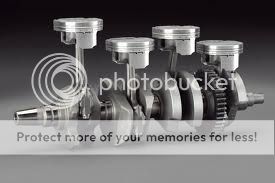How about this one. It's a Yamaha "crossplane" motorcycle engine originally invented for their racing bikes. It is meant to provide equal firing pulses theoretically resulting in enhanced traction at the rear tire.

Here's the explanation:
So Yamaha’s new R1 (read the test report here) has a cross-plane crankshaft: what’s that all about? A conventional four-cylinder engine has its crankpins all in the same plane – a flat-plane crank – with the two inner ones 180 degrees from the two outer ones. The inner two pistons move up and down together, and so do the two outer ones, and it’s this particular configuration which generates something called inertial torque. This is independent of the main torque output generated by the combustion and cylinder pressure and happens entirely because of the crank layout.
Crossplane_03Click on image for galleryTo understand it, first imagine a crankshaft on its own, no pistons or conrods, spinning in friction-free bearings. There’s nothing to slow it down or speed it up so it just keeps spinning at a smooth, constant speed. Now attach the conrods and pistons, and for the sake of this mind experiment, we’ll make them friction-free too, so you can spin the crank again and the pistons bob up and down, and the whole system keeps on rotating and reciprocating. At this stage there’s no combustion or valve gear or anything to confuse the issue, and crucially, there is no energy being put into our system and none being extracted or lost. This matters because it is a fundamental law of the universe that energy cannot be created or destroyed, only converted into another form – physicists know this as the first law of thermodynamics.
Within this system, the pistons are travelling at high speed when they’re half way along their cylinders, and at this point they have a lot of kinetic energy. Yet 90 degrees of crankshaft rotation later, all four pistons are stationary, two at the top, two at the bottom. Their kinetic energy hasn’t simply vanished because it can’t: instead it’s been transferred to the crankshaft, which was responsible for slowing the pistons down. As a result, the crank itself has increased its speed. Another 90 degrees on and the pistons are back up to maximum speed, accelerated by the crank which has returned some energy to them and in turn, it’s slowed down again.
Crossplane_02In a full rotation the crank will have sped up and slowed down twice, generating rapid negative and positive torque pulses completely independent of the torque produced by the combustion. This constant pulsing torque is like a background noise to the main torque output, blurring its edges and taking away a small element of rider control and precision as he tries to hold the back tyre on the very edge of its grip.
On Yamaha’s cross-plane crankshaft, these fluctuations are all but eliminated. In this layout the crankpins are distributed at 90 degrees to each other around the crankshaft (in two planes which form a cross). So as one piston is slowing down and losing energy to the crank, another is speeding up and taking the same amount back. At no point do all the pistons stop together, as they do on a flat-plane crank. Instead the energy flow is evened out and the rotation of the crank is almost completely smooth and steady.
Although I’ve talked about the torque fluctuations as background noise, in fact the scale of them is massive, dwarfing the conventional, output torque by a factor of ten. In a GSX-R1000 engine at 12,000rpm for example, the inertial torque swings from around +500 to –500lb.ft (69kg.m, 680Nm) twice in every revolution of the crank.